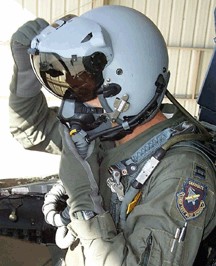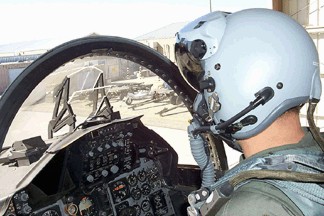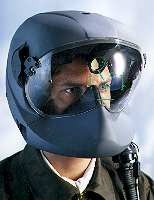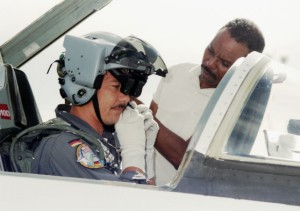|
History
During air combat, speed is the key word. One look down in the
cockpit can make the difference between life and death. Once
realizing this, aircraft manufacturers started displaying
information in front of the pilot. This device is known as Head
Up Display, HUD. During air combat tracking possibilities are
limited to this small HUD area.
In the early eighties, the Soviet Union started production on
the MiG-29 and Su-27 and incorporated a helmet sight. This
simple sight was put on the helmet and allowed the pilot to look
at a target and make a lock. In the west different companies
started development at same time.
DASH
In 1984 Elbit Systems of Israel started the work on the DASH
helmet (Display And Sight Helmet). This helmet is now known as
the DASH Generation I Mk.222A. In 1988, Elbit made the DASH
Generation III prototype which saw production in 1989. From this
design several slightly different models were made, depending on
the aircraft it was mend for. The DASH is fully operational on
the major Israeli fighters and is also used on the refurbished
MiG-21 and F-5E/F.

DASH helmet
Agile
Eye
Kaiser Electronics started their development in 1986 on the
Agile Eye. The Agile Eye Plus superceded this in 1990, other
improved versions were developed until the venture with Elbit.
The teaming up for the JHMCS contract started in 1996 and the
joint venture was formed under the name of VSI Vision Systems
International LLC.
JHMCS
|
JHMCS
combines a magnetic head tracker with a display projected
onto the pilot's visor, giving the pilot a targeting
device that can be used to aim sensors and weapons
wherever the pilot is looking. With JHMCS, the pilot can
aim the radar, air-to-air missiles, infrared sensors, and
air-to-ground weapons merely by pointing his/her head at
the target and pressing a switch on the flight controls.
Additionally, the pilot can view any desired data
(airspeed, altitude, target range, etc.) while
"heads-up", eliminating the need to look into
the cockpit during visual air combat.
A pilot can adjust the helmet's display to go blank when
he's looking either at the HUD or down into the cockpit.
He can also programme it to go blank for both areas.
The JHMCS is a device that can be hooked up to the
HGU-55/P, HGU-56/P and
HGU-68/P helmets. Testers are initially developing JHMCS
on an F-15.
Simultaneous development is being conducted on the Navy's
F/A-18. Once the
system is developed on these aircraft, it can be
integrated into the F-16, the F-22 and the joint strike
fighter. As with the DASH III, the prototype JHMCS helmets
are based upon the HGU-55/P helmet shell. As the USAF
decided to choose the HGU-86/P for its new F-22, and
possible entire fighter fleet, the JHMCS has to be
redesigned to fit this Alpha HGU-86/P.
|
 |
Specifications
-
Tested
ejection safe to 450 KEAS
-
Modular
Design - quickly and easily convertible to night vision
system
-
Redundant
quick release connectors for safety
-
In-flight
video recording (camera in helmet)
-
Up-look
reticles
-
Advanced
head tracker system

AIRCRAFT
F-15, F-16, F-18, F-22
FIELD OF REGARD UNLIMITED
FIELD-OF-VIEW 20° MONOCULAR, RIGHT EYE
EXIT PUPIL 18 MM
EYE RELIEF > 50 MM
COMPATIBLE HELMETS HGU-55/P(CE), HGU–56/P, HGU-68/P
HMD WEIGHT 4.2 LBS WITH O2 MASK
MTBR 1000 HOURS
LOS COMPUTER UNIT SIZE/WEIGHT 14.3" x 7.9" x 5.3"
/ <26 LBS

For
use on the Rafale the Sextant Avionique Topsight is developed.
At
the same time for use on the Eurofighter GEC Marconi is making
the HMD. More info on this can be found in Tim Ripley's article
in the Stories section of our Website.

|